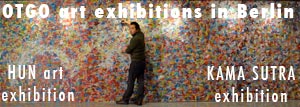 'ZURAG' film original in German 2010 Berlin
'ZURAG' film original in German 2010 Berlin'ZURAG' film in the Mongolian national television, 2011 Ulan Bator
(Original record from the MNB broadcast)
 'ZURAG' film original in German 2010 Berlin
'ZURAG' film original in German 2010 Berlin| Deutsch
- Zweites
Kapitel: Tschingis
Chaans Jugend English - Second Chapter: Genghis Khan's Youth info: Zanabazar Zanabazar, also known as Öndör Gegeen Zanabazar (Mongolian: Өндөр гэгээн Занабазар, 1635-1723), was the first Jebtsundamba Khutuktu, the spiritual head of Tibetan Buddhism for the Khalkha in Outer Mongolia. Background Zanabazar (his given name is Eshidorji, Ишдорж) was born as son of the Tüsheet Khan Gombodorj- at that time one of the three Khans in Khalkha- and his wife, Khandojamtso. Zanabazar became a religious leader in Eastern Mongolia. In that time Western Mongolia had gained in power under Galdan Boshogtu Khaan. Galdan Boshogtu descending from not Golden Lineage of Chingis khaan tried to unite all the Mongolian States and take the throne for himself. Zanabazar declined all the Western Mongols' proposals. Finally Galdan Khaan decided to re-unite the Mongol States by force and collaborated with rising power on the north Russia and in south Manchus against Eastern Mongolia. Thousands of warriors from the Western Mongol Empire went to war with Eastern Mongolia. When Galdan Khaan's army came to the area where today the city of Ulaanbaatar is located, conducting two wars in front, on the north with Russia on the west with Galdanboshogtu, Zanabazar escaped to Southern Mongolia. The Manchus were interested in defeating both Mongolian states, and this gave them an incredible chance to accomplish that goal. The Manchu army went to war with the Western (Oirad) Mongol Empire, Zanabazar's goal. After the battle at Zuun Mod (near present-day Ulaanbaatar) the Oirad Mongol warriors were defeated and went back to the west. Zanabazar became a religious leader in Mongolia while his native land (Eastern Mongolia) fell to and became a vessel of the Manchus. Recognition In 1640 Zanabazar was recognized by the Panchen Lama and the Dalai Lama as being a "Living Buddha", and he received his seat at Örgöö, then located in Övörkhangai- 400 miles from the present site of Ulaanbaatar- as head of the Gelug tradition in Mongolia. Miraculous occurrences allegedly took place during his youth, and in 1647 (aged 12) he founded the Shankh Monastery. Contribution to arts Zanabazar has been called the "Michelangelo of Asia" for bringing to the region a renaissance in matters related to spirituality (including theology), language, art, medicine, and astronomy. He composed sacred music and mastered the sacred arts of bronze casting and painting. He created a new design for monastic robes, and he invented the Soyombo script in 1686- based on the Lantsa script of India, as well as the Quadratic Script- based on the Tibetan and Phagspa scripts. Many people still believe that Zanabazar personally created many tankas and bronze statues of Buddha, but a more realistic idea is that he founded a school of Buddhist art. The talented monks of his school created many figures of Buddha. The scholar Ragchaagiin Byambaa has suggested that both of the scripts invented by Zanabazar were combined to write in a tripartite "Dharma" language composed of Tibetan, Mongolian and Sanskrit, because, he says, the two scripts were specifically designed to better accommodate the phonetics of all three languages. At present, they are mainly used for sacred and ornamental Buddhist inscriptions and among learned Buddhist scholars in Mongolia. Jebtsundamba Khutuktu The Khalkha Jebtsundamba Khutuktus (Mongolian: Жавзандамба хутагт, Javzandamba Khutagt; Jetsun Dampa; literally, "Holy Venerable Lord") were the spiritual heads of the Gelug lineage of Tibetan Buddhism in Mongolia. They also held the title of Bogd Gegeen, making them the top-ranked lamas in Mongolia. The first Jebtsundamba, Zanabazar (1635-1723), was identified as the reincarnation of the scholar Taranatha of the Jonang school of Tibetan Buddhism. Zanabazar was the son of the Tüsheet Khan Gombodorj, ruler of central Khalkha Mongolia, and himself became the spiritual head of the Khalkha Mongols. Like Zanabazar, the second Jebtsundamba also was a member of Mongolia's highest nobility and direct descendant of Genghis Khan. After Chingünjav's rebellion and the successive demise of the second Jebtsundamba Khutugtu, the Qianlong emperor decreed in 1758 that all future reincarnations were to be found from among the population of Tibet. When northern Mongolia declared independence in 1911, the eighth Jebtsundamba (1869-1924) was elevated as the Emperor of Mongolia, called Bogd Khan. He was the head of state until his death in 1924. The Communist government declared that there were to be no further reincarnations. A reincarnation was in fact found almost at once in north Mongolia, and some high lamas of the dead Khutughtu's suite went to interview the child's mother, Tsendjav, and to instruct her in the details of the life of the former incarnation, so that she could familiarize the child-candidate with the tests which he would have to undergo. Faced with the possibility of a new Khutughtu who was born within Mongolia and was not even a foreigner from Tibet, the Communist Party Central Committee in July 1925, decided to turn the matter over to the aged Dalai Lama in Lhasa, whose decision would nonetheless be subject to the new law for the separation of Church and State. In February 1929 the installation of any further Khutughtus was forbidden. A 9th Jebtsundamba Khutuktu has been installed by the Dalai Lama. He was born as Jampal Namdol Chökyi Gyaltsen in 1932. Notes
Text from Wikipedia |